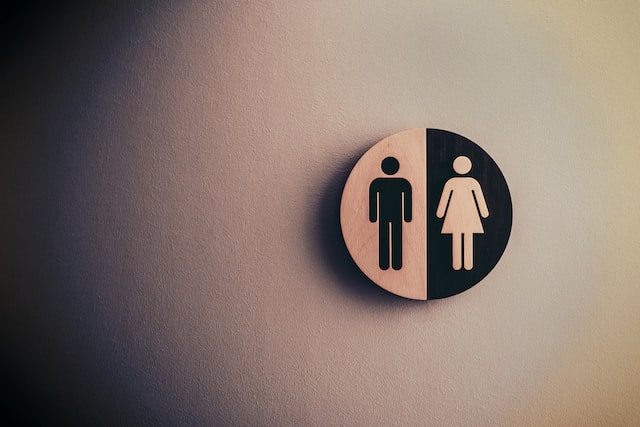Misogyny and chauvinism both involve the objectification of women, but they differ in their underlying motivations. Chauvinism is often rooted in a sense of superiority or entitlement while misogyny stems from a deep-seated hatred for women.
Chauvinism
Chauvinism is a form of extreme patriotism or nationalism that can be characterized by a belief in the superiority of one’s own country, culture, or gender. It is often associated with a belief that one’s own group is superior to other groups, and can lead to discriminatory or aggressive behaviour towards those perceived as being different. In a gender context, chauvinism refers to the belief in the inherent superiority of men over women and can manifest in attitudes and behaviours that discriminate against women and undermine their rights and opportunities. It is considered a form of sexism and misogyny and is widely considered a negative attitude.
Misogyny
Misogyny is the hatred of, contempt for, or prejudice against women or girls. It manifests in numerous ways, including social exclusion, sex discrimination, hostility, and sexual violence. Misogyny can be found within different societies and groups, including radical feminists and men’s rights activists.
The Difference Between Chauvinism and Misogyny
The commonality between chauvinism and misogyny is that they both involve negative attitudes and beliefs about women. Chauvinism is the belief that women are inferior to men and should be treated as such. Misogyny is a hatred or strong dislike of women. Both chauvinism and misogyny can manifest in individual attitudes or in institutional policies and practices.
While chauvinism and misogyny share some common features, there are also important differences between them. Chauvinism is primarily a attitude problem, while misogyny is primarily a behavior problem. Chauvinists may not act on their beliefs, but misogynists will often go out of their way to hurt, belittle, or degrade women. Additionally, chauvinism tends to be more about an overall belief in female inferiority, while misogyny is more targeted hatred towards individual women (or groups of women).
What is the difference between misogynistic chauvinistic?
(Photo by photo nic on Unsplash )

When it comes to gender relations, chauvinism and misogyny are two words that are often used interchangeably. However, there is a big difference between the two concepts. Chauvinism refers to an exaggerated or aggressive patriotism, while misogyny is a hatred or distrust of women.
So, while chauvinism can simply be seen as an over-enthusiasm for one’s country, misogyny is a much more deeply rooted problem that manifests itself in many different ways. For example, misogynistic men may believe that women are inferior to men, or that they are only good for certain roles (e.g. cooking and cleaning). They may also objectify women and see them as nothing more than sex objects.
Misogyny can have dangerous consequences, both for individual women and for society as a whole. It can lead to sexual harassment and assault, as well as domestic violence. In addition, it can create an atmosphere in which women feel devalued and uncomfortable speaking up about their own experiences and needs.
Chauvinism, on the other hand, while it may be irritating at times, is not nearly as harmful as misogyny. It is possible for a chauvinist to respect and value women without seeing them as inferior to men. So, while both chauvinism and misogyny are problems that need to be addressed, it’s important to remember that they are not the same thing.
Examples of Chauvinism and Misogyny
There are many examples of chauvinism and misogyny in our society. Here are a few:
1. Men who think that women are inferior to them and that they should not have the same rights as men.
2. Men who think that women exist solely for their pleasure and that they can do whatever they want to them without any consequences.
3. Men who refuse to believe that women can be just as successful as men and that they deserve the same opportunities.
4. Men who use degrading and offensive language towards women or treat them like objects instead of human beings.
What’s the difference between misogyny and patriarchy?
There is a big difference between misogyny and patriarchy. Patriarchy is a system of male domination in which men hold primary power over women. Misogyny is the hatred of, contempt for, or prejudice against women. While misogyny is certainly a part of patriarchy, it is not the same thing.
Patriarchy exists in nearly every culture around the world and has existed for thousands of years. It manifests in different ways depending on the culture, but some common features include:
Misogyny, on the other hand, is not an innate or universal feature of patriarchal cultures. It is a specific attitude or belief that hatred towards, or mistreatment of, women is justified. In some cultures, misogyny is openly encouraged and even celebrated, while in others it may be more subtle and hidden. But even in cultures where misogyny is not overtly condoned, it can still be a powerful force shaping how both men and women think about and interact with each other.
What is the difference between patriarchy and matriarchy?
Patriarchy
Patriarchy is a social system in which men hold primary power and predominate in roles of political leadership, moral authority, social privilege, and control of property. Here are some common features of patriarchy:
- Male domination: Men are considered the dominant gender and hold more power and privilege than women in most areas of life.
- Gender roles: Society has strict expectations for how men and women should behave, with men expected to be assertive, dominant, and unemotional, and women expected to be passive, nurturing, and emotional.
- Male-centered culture: Society is organized around the needs and interests of men, and women’s contributions and perspectives are often overlooked or devalued.
- Female subordination: Women are expected to be subservient to men and are often denied the same opportunities and rights as men.
- Control of women’s bodies: Patriarchy often involves the control of women’s reproductive rights, sexual behavior, and physical autonomy.
- Violence against women: Patriarchy is often associated with the use of physical and sexual violence against women as a means of maintaining control over them.
- Male privilege: Men enjoy benefits and privileges simply for being men, such as higher pay, more opportunities for advancement, and greater representation in positions of power.
- Societal expectation for masculinity: Men are expected to be tough, independent, and dominant, and that not adhering to these expectations is seen as weak.
Matriarchy
Matriarchy is a social system in which women hold primary power and predominate in roles of political leadership, moral authority, social privilege, and control of property. Here are some common features of matriarchy:
- Female dominance: Women are considered the dominant gender and hold more power and privilege than men in most areas of life.
- Gender equality: Society promotes equality between men and women and does not have strict expectations for how individuals should behave based on their gender.
- Female-centered culture: Society is organized around the needs and interests of women, and men’s contributions and perspectives are valued equally.
- Male subordination: Men are expected to be subservient to women and are often denied the same opportunities and rights as women.
- Control of reproductive rights: Matriarchy often involves the control of reproductive rights, sexual behavior, and physical autonomy for both men and women.
- Non-violence: Matriarchy promotes non-violence and peaceful resolution of conflicts.
- Female privilege: Women enjoy benefits and privileges simply for being women, such as equal pay, equal opportunities for advancement, and equal representation in positions of power.
- Societal expectation for femininity and masculinity: There is no pressure to conform to societal expectations of femininity and masculinity, individuals are free to express themselves as they see fit.
It’s worth noting that the concept of a fully-developed Matriarchal society is considered as a hypothetical and not well-documented, as there are very few examples of such societies in human history, and many of the examples that are cited as matriarchal have been shown to be more complex.
What are examples of being misogynistic?
Misogyny is the hatred, dislike, or mistrust of women.

It’s important to note that misogyny can take many forms and can be both overt and subtle. It can be expressed through words and actions, and can be perpetuated by individuals, institutions, and societal norms. It’s also important to recognize that misogyny can be directed towards any woman, regardless of their race, ethnicity, age, sexual orientation, or socioeconomic status.
What is opposite of chauvinism?
The opposite of chauvinism is typically considered to be humility, respect and equality. Chauvinism is a belief in the inherent superiority of one’s own country, culture or gender. The opposite of this belief would be humility and respect for other cultures and genders. It also includes the belief in equality, treating all people with respect and not having biases based on gender, race, culture, or nationality.
It’s important to note that there is a term called “anti-chauvinism” which is a belief that one’s own country, culture, or gender is not inherently superior to others. But it’s also not the opposite of chauvinism, as it still implies a belief in the concept of inherent superiority.
The opposite of chauvinism is to reject the belief in the inherent superiority of any group and to treat all people as equals, with respect, dignity, and without discrimination.
What is misandry?
(Image by Mohamed Hassan from Pixabay )
Misandry is the hatred, dislike, or mistrust of men. It is the counterpart of misogyny, which is the hatred, dislike or mistrust of women. Misandry can manifest in a variety of ways, including but not limited to:

- Holding negative stereotypes about men, such as thinking they are violent, aggressive, or less intelligent than women
- Disrespecting or disregarding men’s opinions or perspectives
- Using derogatory or sexist language to describe men
- Holding double standards for men and women
- Blaming men for their own victimization
- Disrespecting or disregarding men’s contributions and achievements
- Justifying or excusing violence against men
- Holding men responsible for the actions of other men.
Misandry, like misogyny, can take many forms and can be both overt and subtle. It can be expressed through words and actions, and can be perpetuated by individuals, institutions, and societal norms. As with misogyny, it’s important to recognize that misandry can be directed towards any man, regardless of their race, ethnicity, age, sexual orientation, or socioeconomic status. Additionally, it’s important to note that the presence of misandry doesn’t negate or excuse misogyny, both are harmful and should be rejected.
What is the psychology of misogyny?
The psychology of misogyny is the study of hatred, fear, and hostility towards women. It is a branch of psychology that deals with gender-based prejudice and discrimination. Misogyny can be manifested in many different ways, such as through sexual harassment, domestic violence, or rape.
Misogyny is often perpetuated by a lack of understanding or knowledge about women. Misogynists may view women as inferior to men, and this can lead to a feeling of entitlement or superiority over them. This feeling of entitlement can manifest itself in different ways, such as through a need to control or dominate women. In some cases, this sense of entitlement may even lead to violence against women.
Misogyny is often rooted in sexism, which is the belief that one sex is innately better than the other. Sexism can be defined as “the belief that people should be treated differently based on their sex rather than their individual merits or abilities” (examples include gender-based pay disparities and occupational segregation). Sexism leads to discrimination against one sex, which can then lead to misogynistic attitudes and behaviours.
There are many different factors that contribute to the development of misogyny. Some of these include: exposure to sexist messages (such as through advertising), negative experiences with women (such as being rejected romantically), a sense of powerlessness or inadequacy, and socialization into traditional gender roles (such as those that place a higher value on masculinity).
What is androcentrism
Androcentrism is the practice of viewing the world and society from a male-centered perspective, often leading to the marginalization or exclusion of women. It can manifest in various ways, such as assuming that men are the default or norm in language, social roles, and decision-making processes. It is a form of bias and can have negative impacts on individuals and society as a whole.
Frequently asked questions about chauvinism and misogyny
What is the word for female superiority?
The word for female superiority is feminism. Feminism is the belief that women are equal to or better than men. It is also the name for the political movement that seeks to achieve equality for women.
What is the word for male sexism?
There is no one word for male sexism. However, chauvinism and misogyny are two terms that are often used to describe it. Chauvinism is a form of sexism that is characterized by an exaggerated sense of male superiority. Misogyny is a form of sexism that is characterized by a hatred or dislike of women.
What do you call a woman who disrespects men?
A woman who disrespects men is called a chauvinist. A chauvinist is someone who believes that one sex is superior to the other. Misogyny is a form of sexism that targets women specifically. It is the hatred or dislike of women.
Why do females prefer dominant males?
There are many reasons why females may prefer dominant males. One reason is that dominant males tend to be more protective and attentive to their mates and offspring. Another reason is that dominant males often have access to better resources, which can improve the quality of life for their mates and offspring. Finally, dominant males typically have a higher social status than other males, which can confer greater benefits on their mates and offspring.
What is the difference between a misogynist and a feminist?
chauvinism is the belief that one gender is superior to another, while misogyny is hatred or distrust of women. Chauvinists may not necessarily hate women, but they do believe that men are better than women. feminists, on the other hand, believe in equality for all genders.
Featured Image By – Photo by Tim Mossholder on Unsplash









